You might have heard about historical dynasties of Iran and the order in which they came to power; But there are few people who know that the history of Iran does not end with these dynasties and that this ancient land dates back to the era before the invention of writing. If you only have time to visit one museum in Tehran, we recommend visiting the National Museum of Iran. This museum is the largest and oldest museum in the country where the most archaeological findings from scientific explorations related to different eras are kept. These works include from the Paleolithic era to the Islamic era, which have been prepared for the public to visit in the form of two museums, “Ancient Iran Museum” and “Museum of Islamic Archaeology and Art of Iran”.
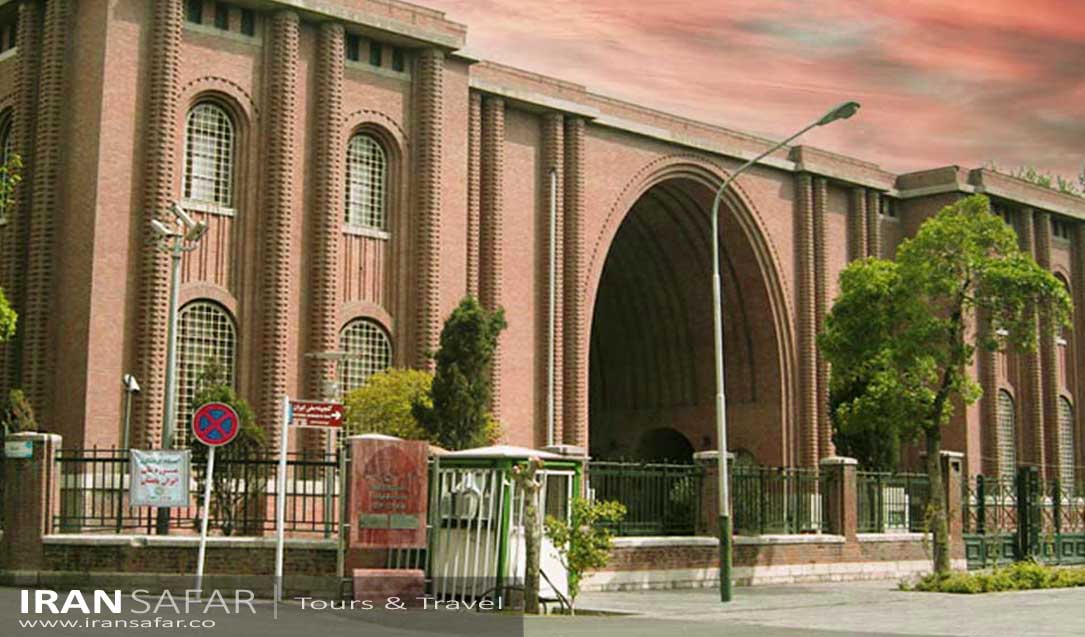
History of National Museum of Iran
With an age of more than 80 years, the National Museum of Iran is one of the richest museums in the capital. It was in 1295 that a Qajar noble called Mumtaz al-Mulk converted one of the rooms of Dar al-Fonoun School into a museum in which he collected more than 270 historical objects. After a period of time when some more archaeological excavations started (1927), the absence of a proper museum was strongly felt, and as a result, the order to build a museum was issued by Reza Shah Pahlavi. A French architect and archaeologist called André Godard was appointed to design a suitable museum.
By studying the style of Iranian architecture and inspired by the Arch of Ctesiphon (Taq Kasra), André Godard designed a plan according to the architecture and history of Iran. This plan was given to Iranian architects in 1935 to start the construction operation, and finally, after two years of operation, the National Museum of Iran was inaugurated.
Iran National Museum – Sections
The National Museum of Iran consists of two separated buildings. The building with red bricks and a large arched entrance is the Museum of Ancient Iran. This old building is devoted to the prehistoric and historical periods before the Islamic Era of Iran. On the right side of this old building, you will see a relatively new building which is the Museum of Islamic Archaeology and Art of Iran.
This museum, displays objects from the early Islamic era until the Qajar period and is also known as Islamic Museum.
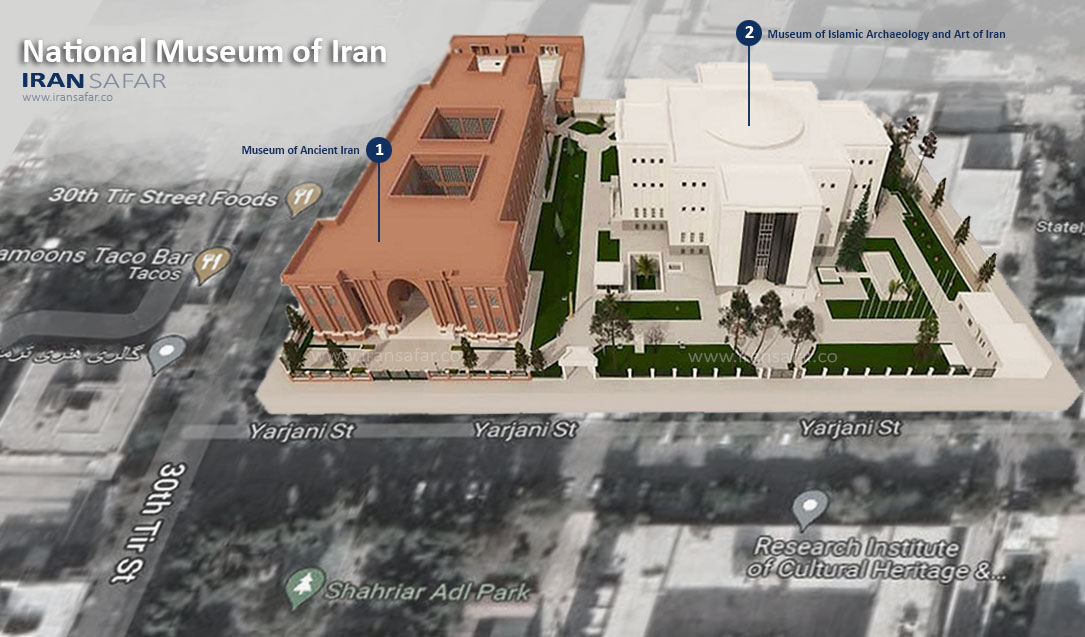 Iran National Museum, Site Plan
Iran National Museum, Site Plan
1
Museum of Ancient Iran
The Museum of Ancient Iran is a two-story building. On the first floor of the museum, you will find artifacts from the Paleolithic, Neolithic, copper and stone ages. On the ground floor of this building, the visit to the Bronze and Iron Age began and continued with the Achaemenid and Seleucid periods and will end in the Parthian and Sassanid periods.
Site Plan – Museum of Ancient Iran
Click on the map to enlarge
 Museum of Ancient Iran – Site Plan
Museum of Ancient Iran – Site Plan
First Floor: Prehistoric Period
To see this section, you have to go to the first floor (above the ground floor) and we recommend that you start your visit to this museum from this floor, because in this section you can find objects from the oldest era of human life, i.e. the Paleolithic era, to the end of the 4th millennium BC, i.e. from the oldest era. You will see the writing before the invention. Stone tools from the Paleolithic era, pottery from important archaeological sites and areas, human and animal clay figurines, and a clay replica of the flint hill are among the sights of this era.
Ground Floor: Historical Period
After walking around in the prehistoric era, by going to the ground floor, you will enter the world of history and civilization, and in fact, the historical era. In this floor, works from the end of the fourth millennium BC, i.e. the beginning of the use of writing, until the end of the Sasanian Empire, are displayed. Among the prominent objects of this section, we can mention the world’s oldest animation on clay from the burnt city, the statue of Darius I, the bronze statue of Zavi Shami man and the salt man of Zanjan mine.
2
Museum of Archaeology and Islamic Art
The Museum of the Islamic Period is a three-story building, the ground floor of which is dedicated to holding temporary exhibitions and meeting halls. The first floor is dedicated to works from the Timurid, Safavid and Qajar periods, and on the second floor you will see works from the Early Islamic period, Seljuk and Ilkhanid Era.
Site Plan – Museum of Archaeology and Islamic Art
Click on the map to enlarge
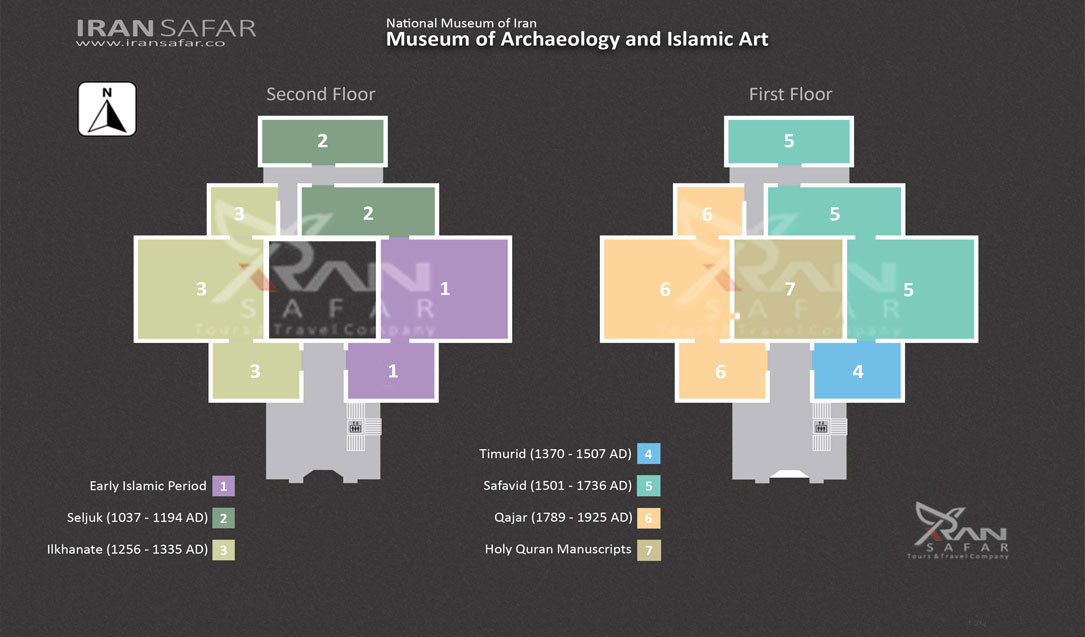 Museum of Archaeology and Islamic Art – Site Plan
Museum of Archaeology and Islamic Art – Site Plan
Highlight Items
Of course, all historical and ancient objects are valuable and each of them has a unique contribution to express a corner of the long history of Iran and the world, but some works have received much attention due to the antiquity, rarity, historical importance or other specialized reasons. . We introduce some of these works below:
1
Marlik Gold Cup
The Marlik gold cup is one of the gold objects obtained from the excavation of the Marlik cemetery. It was obtained from grave number 26 and belongs to the end of the 2nd millennium and the beginning of the 1st millennium BC. It is 18.6 cm high and is decorated with four mythical winged bulls in the form of a relief engraving. The heads of the bulls are embossed with a hammering technique. Each pair of winged bulls is depicted climbing an ornamental palm-like tree (can be tree of life). These creatures are displayed in the extreme of mobility and liveliness and stand on their hind legs, raise their front legs and lean around the trunk and branches of the tree.
2
Statue of Darius the Great
This broken statue is one of the important works of the Achaemenid period in this museum, which was placed in that area in order to prove the rule of Darius the Great over Egypt. The decorations on this statue were created using hieroglyphs, old Persian cuneiform, Babylonian and Elamite.
This statue of Darius I, was discovered in 1972 during the excavations of the palace of Darius located in Susa by a French-Iranian group led by Jean Perrault. Since 1973, this work has been kept in Iran National Museum. On the base this statue, which was carved in Egypt, there are hieroglyphic decorations, figures, and inscriptions in old Persian, Elamite and Babylonian cuneiform, which indicate that the statue belongs to Darius the Great.
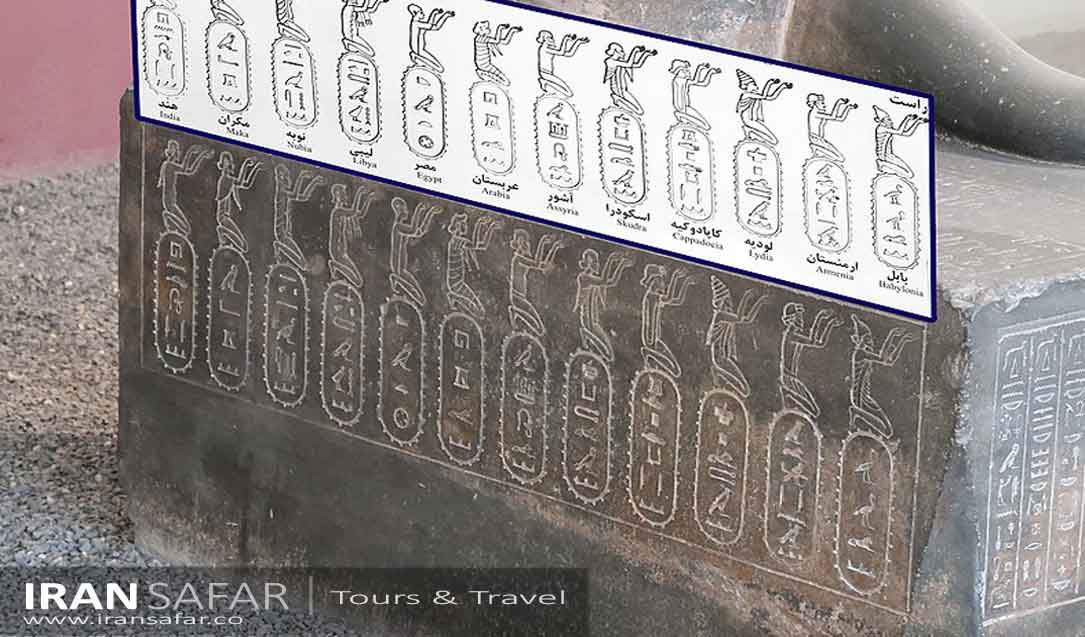
It is stated in the trilingual cuneiform texts: “This is the same stone statue that King Dariush ordered to be built in Egypt so that whoever sees it in the future will know that the Iranians are the owners of Egypt.”
There is also an Egyptian text that states: “Atum, the god of Heliopolis, has chosen him [Darius] to be the lord of all those surrounded by the sun’s rays, knowing that he is his son.”
3
Parthian Man Bronze Statue
Many historical books have mentioned this statue, which is 194 cm high. This statue dates back to 150 years BC and is related to an ancient civilization of the ancient city of Izeh.
This statue, named “Parthian Man”, is considered one of the masterpieces of metal craft and metallurgy of the Elymais. It represents a man wearing a ‘rampa’; loose pants with a cushion type extension in the back. These pants were specially designed for horse riders. It seems that the design of these pants was for them to ride on the horse without saddle , so that they could move the horse with agility and ride easily.
4
Ancient Animation Pottery
Along with all the interesting and important discoveries obtained from the site of Shahr-e Sukhteh (the Burnt City), this object became outstanding when it was proved to be the world’s first animation work ever made. Around this cup, the image of an ibex is displayed, which is changing in five different modes and induces the feeling of watching moving images to the viewer when spinning on a pottery wheel.
5
Jiroft Stone Objects
Jiroft Civilization dates back to 7000 years ago (older than the Mesopotamia civilization). It is known as the oldest civilization of the East, which lived in the fertile plain of Halil-Rud River. In this place, some clay tablets with some inscriptions in a geometrical script were found which have not been deciphered yet. But in general, they can be a fact to explain that Jiroft people could be the inventors of writing, not the Sumerians.
The objects excavated from this civilization also include stone containers, pieces of soapstone and bronze tools. The most important findings from the region are carved soapstone objects with a special elegance. On these pieces, there are images such as humans, deities, animals, palms, snakes and scorpions, most of which with inlaid eyes.
6
Guardian Bull
This statue was obtained from the front gate of the Ziggurat of Chaghazanbil. The role of this figure at the entrance door was to guard the temple. The bull dates back to about 1250 years BC. Roman Ghirshman and his wife put the discovered pieces of this body together and delivered them to the National Museum of Iran.
An inscription is written in Elamite script on the bull’s back:
Salt Man Mummy
In the Sasanian Era zone of Museum of Ancient Iran, there is a showcase displaying head and leg of a naturally-mummified human. The salt man is one of six natural mummies discovered in a salt mine in Zanjan province.
In 1994, while excavating and extracting salt, miners in the western region of Zanjan city , encountered parts of a man’s body. After being notified by the Zanjan Cultural Heritage Department, the exploration of the area began soon. These excavations led to the discovery of a leg inside a leather boot, a head with beard and long hair and gold earring in the left ear, three knives, shorts, a silver object, a stone hook, pieces of leather rope, a saber stone, a walnut, pieces of pottery and some pieces of patterned cloth and crushed pieces of bones.
By carrying out carbon 14 dating tests on the bones and fabrics of the Salt Man collection, an age of about 1700 years ago (late Parthian – early Sasanian) was determined for the Salt Man.
FAQs – Iran National Museum
1. What is the largest museum of Iran?
The National Museum of Iran is the largest and the oldest museum of Iran located in Tehran. It houses an extensive collection of artifacts spanning thousands of years.
2. What are the museum’s main attractions?
The museum showcases a diverse array of artifacts, including ancient pottery items, sculptures, manuscripts, and historical relics from different periods of Iranian history.
3. When was the National Museum of Iran built?
The museum was founded in 1937 and underwent several expansions and renovations.
4. What is the significance of the museum’s architecture?
The museum’s architecture is a blend of modern and traditional Iranian styles, making it a visual treat for visitors. Its iconic entrance gate, inspired by ancient Persia, is a must-see.
5. How many sections has the national museum of Iran?
The museum is divided into two main sections: the Museum of Ancient Iran and the Museum of Islamic Era. Each section offers a chronological journey through Iran’s history.
6. What are the museum’s visiting hours and ticket prices?
The National Museum of Iran is usually open from 09:00 to 17:00. Ticket prices vary for locals and foreigners. The entrance fee for foreign visitors is 1.000,000 IRR – It is advisable to check the latest information before planning your visit.
7. Are there any guided tours available?
Yes, the museum offers guided tours and educational programs for students and tourists interested in Iran’s history and culture.
8. Can visitors take photographs inside the national museum of Iran?
Generally, photography is allowed in all parts of the museum, but it’s essential to respect restrictions and guidelines.
9. Is Iran national museum accessible to people with disabilities?
Efforts have been made to make the museum accessible, with ramps, lifts, and facilities for disabled visitors.
10. What nearby attractions can visitors explore after visiting the National Museum of Iran?
After the museum, you can explore other fascinating sites in Tehran, such as Golestan Palace, Azadi Tower, and the Grand Bazaar.

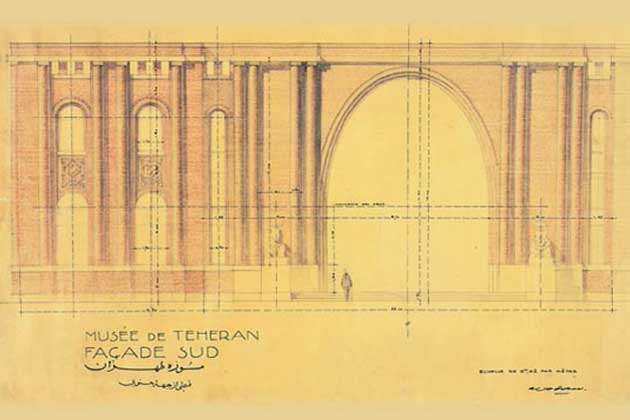

Remember that large bags and backpacks are not allowed to the museum. Either don’t bring them with you or leave them at the deposit box. There is a depository in the National Museum of Iran where you can hand over some of your belongings. Remember that the items you hand over, must be picked up on the same day.
Hello, I don’t recommend to use your own car to go to Iran National Museum because the access road to the museum is inside the congestion zone of Tehran. The means of public transportation that you can use to go to the museum are: Line 2 of Hassan Abad Metro; Taxis and bus terminals to Park-e Shahr station.